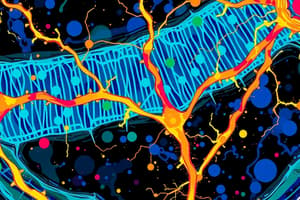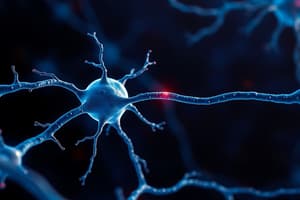Podcast
Questions and Answers
La membrana neuronal es permeable a los iones de cloro (Cl-).
La membrana neuronal es permeable a los iones de cloro (Cl-).
False (B)
El potencial de membrana en una neurona típica puede variar entre -60 y -75 milivoltios (mV).
El potencial de membrana en una neurona típica puede variar entre -60 y -75 milivoltios (mV).
True (A)
El potencial de Nernst para iones de calcio (Ca2+) es el mismo que el potencial registrado de la membrana en las neuronas.
El potencial de Nernst para iones de calcio (Ca2+) es el mismo que el potencial registrado de la membrana en las neuronas.
False (B)
La membrana neuronal es permeable principalmente a los iones de sodio (Na+).
La membrana neuronal es permeable principalmente a los iones de sodio (Na+).
El potencial eléctrico a través de la membrana neuronal es conocido como el potencial de Nernst.
El potencial eléctrico a través de la membrana neuronal es conocido como el potencial de Nernst.
La selectividad de la membrana neuronal permite que todas las moléculas pasen libremente sin restricción.
La selectividad de la membrana neuronal permite que todas las moléculas pasen libremente sin restricción.
La membrana neuronal mantiene un gradiente de concentración de iones como Na+, K+ y Cl- a través de la membrana.
La membrana neuronal mantiene un gradiente de concentración de iones como Na+, K+ y Cl- a través de la membrana.
Cambios en la composición lipídica o estructura molecular de la membrana neuronal no han sido relacionados con enfermedades como el Alzheimer o Parkinson.
Cambios en la composición lipídica o estructura molecular de la membrana neuronal no han sido relacionados con enfermedades como el Alzheimer o Parkinson.
El colesterol no es importante para mantener la estabilidad de la arquitectura de la membrana neuronal.
El colesterol no es importante para mantener la estabilidad de la arquitectura de la membrana neuronal.
Los oligómeros de alfa-sinucleína pueden formar poros en la membrana neuronal que causan mejoras neuronales.
Los oligómeros de alfa-sinucleína pueden formar poros en la membrana neuronal que causan mejoras neuronales.
La investigación ha demostrado que los impactos de explosiones en neuronas no causan ningún daño visible a nivel microscópico en la membrana neuronal.
La investigación ha demostrado que los impactos de explosiones en neuronas no causan ningún daño visible a nivel microscópico en la membrana neuronal.
La permeabilidad selectiva a iones y el mantenimiento de gradientes electroquímicos son fundamentales para la generación y transmisión de señales neuronales.
La permeabilidad selectiva a iones y el mantenimiento de gradientes electroquímicos son fundamentales para la generación y transmisión de señales neuronales.
Flashcards are hidden until you start studying
Study Notes
Understanding the Neuronal Membrane
The neuronal membrane is a vital component of neurons, playing a crucial role in the transmission of electrical signals within the nervous system. It is a selectively permeable barrier that separates the intracellular environment from the extracellular space, maintaining electroneutrality and osmotic balance. The membrane is composed of phospholipids, proteins, carbohydrates, and cholesterol, which together create a complex structure that regulates the movement of ions and other molecules.
Ion Movement and Membrane Potential
The neuronal membrane is highly permeable to potassium (K+) ions but only slightly permeable to sodium (Na+) and chloride (Cl-) ions. This selective permeability creates an electric potential across the membrane known as the membrane potential. In most neurons, this potential ranges between -60 and -75 millivolts (mV), with the inside of the plasma membrane having a negative charge compared to the outside. The equilibrium electrical potential at which the inside of the membrane is more negative than the outside is called the Nernst potential for K+ ions. However, it's not exactly the same as the recorded membrane potential because K+ is not the only ion affecting the membrane potential.
The neuronal membrane is also semipermeable, meaning it allows certain substances to pass through while restricting others. This selectivity is crucial for the proper functioning of the nervous system. For example, the neuronal membrane maintains a concentration gradient of ions such as Na+, K+, and Cl- across the membrane, which is essential for generating action potentials (APs).
Neuronal Membrane in Disease Conditions
Dysfunction of the neuronal membrane can contribute to neurodegeneration through various mechanisms. For instance, changes in lipid composition or molecular structure of the neuronal membrane have been implicated in Alzheimer's disease (AD) and Parkinson's disease (PD). Cholesterol is particularly important for maintaining the stability of the neuronal membrane architecture, and failures in cholesterol homeostasis can lead to progressive neurodegeneration. Additionally, extracellular alpha-synuclein oligomers may form pores on the neuronal membrane, which could induce neuronal impairments.
Simulating Blast-Induced Membrane Damage
Research has shown that nanoscale modeling of blast impact on neurons reveals microscale pores appearing on the surface of the neuronal membrane. These simulations suggest that even small levels of damage to the neuronal membrane can significantly affect overall model electrical activity. The exact relationship between the number and size of membrane pores and changes in electrical resistance remains under investigation.
In conclusion, the neuronal membrane plays a crucial role in maintaining the integrity and function of neurons. Its selective permeability to ions and maintenance of electrochemical gradients are fundamental to the generation and transmission of neural signals. Understanding how the neuronal membrane functions and how it becomes damaged can provide insights into neurological disorders and potential therapeutic strategies.
Studying That Suits You
Use AI to generate personalized quizzes and flashcards to suit your learning preferences.




